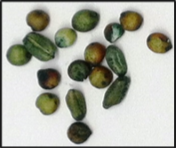By Dr. Christina Wilson, Jonathan Butz, and Mary Mengel

Strychnine, an alkaloid derived from the seeds, tree, and bark of the
Strychnos nux-vomica plant, has historically been used as a potent rodenticide.
1 Although once a restricted use pesticide, strychnine-containing baits are now commercially available over-the-counter as bait blocks or treated grain formulations (red or blue-green in color) and typically contain 0.5% (5,000 ppm) strychnine.
2 These baits are commonly used to control moles, gophers, ground squirrels, coyotes, and wolves. Unfortunately, malicious and accidental poisonings in small animals are becoming more common due to the resurgence in availability and use of strychnine as a pesticide/rodenticide.
Strychnine blocks the inhibitory neurotransmitter glycine and is therefore a potent CNS stimulant. It is rapidly absorbed from the gastrointestinal tract with onset of clinical signs occurring within 10 minutes to 2 hours, depending on the dose.2 The most common clinical sign observed is an acute onset of convulsions or seizures in the exposed animal. Other clinical signs can include hypersensitivity to external stimuli, extensor rigidity or muscle stiffness, uncontrollable muscle spasms, metabolic acidosis, respiratory distress, tachycardia, and death. Strychnine can also cause elevations in the serum enzymes glutamic oxaloacetic acid (SGOT), creatinine kinase (CK), and lactate dehydrogenase (LDH).1
Diagnosis of strychnine poisoning is based on case history and detection of strychnine in biological samples or source material. In suspect cases of poisoning, the following samples can be submitted to the diagnostic laboratory for testing: vomitus, gastric lavage washings, stomach contents, liver, urine, serum, bait, or suspect source material. Differential diagnoses to consider are toxicants that cause CNS stimulation/seizures. These can include exposure to bromethalin, metaldehyde, tremorgenic mycotoxins, organophosphate/carbamate insecticides, pyrethrins/pyrethroids, nicotine, sodium monofluoroacetate, caffeine/theobromine, organochlorine pesticides, neurotoxic cyanobacteria, antidepressant medications, or illicit drugs (LSD, methamphetamine, e.g.). Given the increased use and availability of strychnine-containing baits, it is important to consider strychnine as a differential in cases in which animals have an acute onset of convulsions or seizures.
References
- Gupta, RC (2012) Non-Anticoagulant Rodenticides. In: Veterinary Toxicology: Basic and Clinical Principles. R. Gupta (editor). Elsevier, Inc., San Diego, CA, pp. 548-550.
- Hall, JO (2011) Strychnine. In: Blackwell’s Five-Minute Veterinary Consult, Clinical Companion, Small Animal Toxicology. G. Osweiler (editor) Wiley-Blackwell, Ames, IA, pp. 791-797.